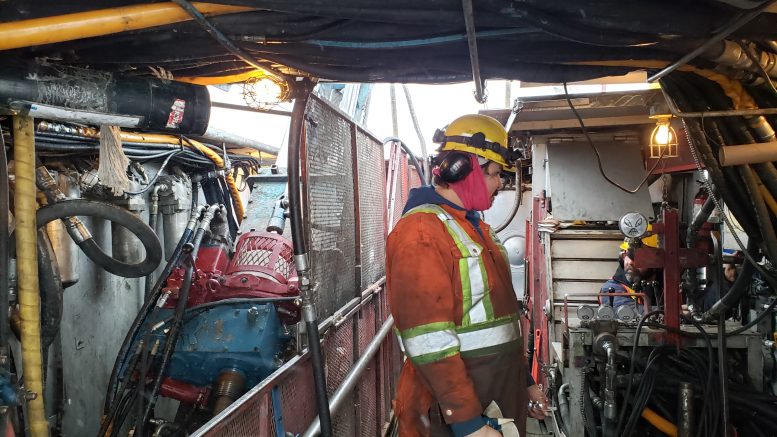Last year was a busy time for Vancouver-based Kenorland Minerals (TSXV: KLD). At the end of July 2020, the junior exploration company made a major grassroots gold discovery at the Regnault target on its Frotet project in the Frotet-Evans greenstone belt of Quebec, 100 km north of Chibougamau.
The discovery, made during an inaugural 15-hole drill program on the 37,480-hectare property, was “nothing short of amazing,” said Zach Flood, Kenorland’s president and CEO.
“We found a new and very significant gold system around five kilometres off the Route du Nord in Quebec, completely concealed undercover, through our systematic approach to grassroots exploration,” he said. “This discovery is in an area of the belt with no known mineral occurrences or historical drilling.”
Kenorland acquired Frotet through staking in 2017 and then optioned it to Sumitomo Metal Mining Canada (US-OTC: SMMYY). Sumitomo holds a majority interest in the project and funded the discovery drill program, while Kenorland continues to be the project’s operator.
Since its founding by Flood and three former colleagues in 2016, Kenorland has focused on project generation and greenfields exploration in mining-friendly jurisdictions with large mineral endowments.
“Over the past four years, prior to going public, we had raised a total of $3 million through private placements and leveraged that into $15 million of partnered-funded exploration,” Flood said. “We’ve grown the company and advanced the portfolio in an organic and sustainable manner with minimal dilution to shareholders.”
The company, he continued, employs a scientific and risk-based approach to exploration, which, he said, is predicated on identifying and acquiring large, underexplored areas of geologically prospective terranes and screening these areas with large-scale geochemical and geophysical surveys.
Kenorland currently controls over 400,000 hectares of mineral rights.

Core sample from the Regnault target on the Frotet property. Credit: Kenorland Minerals.
In 2017, Kenorland also acquired a 100% interest in the Taurus copper-gold-molybdenum project in eastern Alaska. Between 2017 and 2019, the company completed regional soil sampling programs, an airborne ZTEM and magnetic survey covering the entire 45,900-hectare property, and 9,000 metres of drilling that was funded by Freeport McMoRan (NYSE: FCX).
“The project currently hosts a number of known of porphyry related systems and over 30 square kilometres of related hydrothermal alteration,” Flood said. “This is a very large footprint and we suspect there are other porphyry centres which have not been discovered. The regional geochemical and geophysical surveys we completed identified a few significant anomalies which we plan to advance and drill test in 2021.”
The mineralized porphyry systems at the Tanacross project, he noted, are the same geological age and setting as Western Copper and Gold’s (TSX: WRN; NYSE: WRN) Casino copper-gold-molybdenum-silver deposit in the Yukon, about 180 km to the southeast of Tanacross, and is the one of the largest copper-gold projects in Canada.
Kenorland’s recently completed reverse takeover with Northway Resources Corp. brought the Healy project into the company’s portfolio of exploration assets. The 18,470-hectare discovery-stage property was optioned from Newmont (TSX: NGT; NYSE: NEM) and lies about 45 km southeast of Northern Star Resources’ (ASX: NST) Pogo mine, which had produced 3.9 million oz. of gold by 2019.
Newmont had initially identified and staked Healy after numerous years of systematic reconnaissance exploration, including regional stream sampling, in eastern Alaska. Follow up ridge and spur and wide spaced soil sampling led to the identification of a previously unknown gold system, which was expressed as multiple significant gold-in-soil anomalies in an area with no recorded mineral occurrences.
In 2019, Northway completed an initial 10-hole, reconnaissance style, reverse circulation drill program on Healy, confirming the presence of a significant gold system. Follow up geochemical and geophysical surveys in the summer of 2020 defined multiple drill-ready targets that Kenorland plans to test in 2021.
“Following completion of the transaction with Northway, we now have around $9.5 million in the treasury,” Flood said. “We will be fully funded going into 2021 and plan to spend up to $7 million on sole-funded exploration while also managing over $4.5 million of partner-funded exploration.”
The majority of the overall exploration budget, he continued, is primarily focussed on advancing our Frotet, Tanacross, and Healy projects.
In addition to its three flagship assets, the company also has a pipeline of greenfields exploration projects, including the 161,025-hectare Chebistuan project in the northern Abitibi, which is optioned to Newmont, the 51,257-hectare Chicobi project in the central Abitibi, which is optioned to Sumitomo, and the Hunter and O’Sullivan projects, both 100%-owned by Kenorland and also located in the Abitibi.
— The preceding Joint-Venture Article is PROMOTED CONTENT sponsored by KENORLAND MINERALS and produced in cooperation with The Northern Miner. Visit www.kenorlandminerals.com for more information.


Be the first to comment on "JV Article: The next generation of gold prospectors"